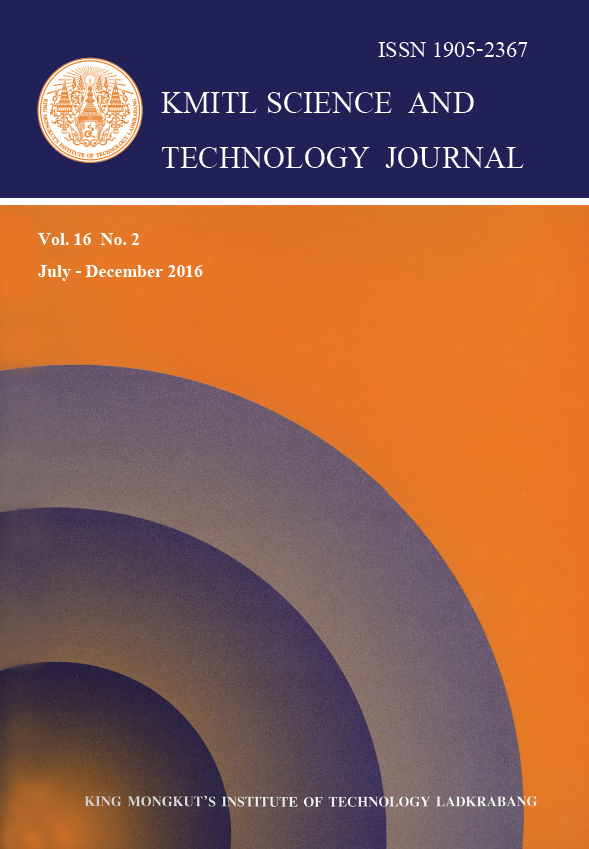Effect of Oxygen Plasma on Tin Oxide Nanorods Prepared by GLAD Technique
Main Article Content
Abstract
In this work, the effect of oxygen plasma with varing plasma power from 100 W to 300 W on tin oxide (SnO2) nanorods prepared by glancing angle deposition (GLAD) technique was studied. The crystal structures were characterized by X-ray diffraction (XRD) technique and the morphology was characterized by field-emission scanning electron microscopy (FE-SEM) technique. Atomic-force microscopy (AFM) revealed that the as-deposited and oxygen plasma-treated tin oxide nanorod structures had orthorhombic phase of SnO2. The degree of crystallinity tended to improve as the plasma power increasd from 100 W to 300 W In addition, the surface roughness of tin oxide nanorods increased with oxygen plasma power increasing. However, the thickness decreased with oxygen plasma power increasing.
Keywords: Oxygen plasma, tin oxide nanorods, GLAD technique
*Corresponding author:
E-mail: Chaiyan.Oro@rmutr.ac.th
Article Details
Copyright Transfer Statement
The copyright of this article is transferred to Current Applied Science and Technology journal with effect if and when the article is accepted for publication. The copyright transfer covers the exclusive right to reproduce and distribute the article, including reprints, translations, photographic reproductions, electronic form (offline, online) or any other reproductions of similar nature.
The author warrants that this contribution is original and that he/she has full power to make this grant. The author signs for and accepts responsibility for releasing this material on behalf of any and all co-authors.
Here is the link for download: Copyright transfer form.pdf
References
[2] Wang, B., Zhu, L.F., Yang, Y.H., Xu, N.S. and Yang, G.W., 2008. Fabrication of a SnO2 nanowire gas sensor and sensor performance for hydrogen. J. Phys. Chem. C, 112(17), 6643–6647.
[3] Sharma, A., Tomar, M. and Gupta, V., 2011. SnO2 thin film sensor with enhanced responsefor NO2 gas at lower temperatures. Sens. Actuators B: Chem., 156(2) 743–752.
[4] Deniz, D., Frankel, D. J. and Lad, R. J., 2010. Nanostructured tungsten and tungsten trioxide films prepared by glancing angle deposition. Thin Solid Films, 518, 4095–4099.
[5] LaForge, J. M., Taschuk, M.T. and Brett, M.J., 2011. Glancing angle deposition of crystalline zinc oxide nanorods. Thin Solid Films, 519, 3530–3537.
[6] Horprathuma, M., Limwicheana, K., Wisitsoraatb, A., Eiamchaia, P., Aiempanakitc, K., Limnonthakuld, P., Nuntawonga, N., Pattantsetakula, V., Tuantranontb, A. and Chindaudom, P., 2013. NO2-sensing properties of WO3 nanorods prepared by glancing angle DC magnetron sputtering. Sensors and Actuators B, 176, 685–691.
[7] Gwon, H.J., Moon, H.G., Jang, H.W., Yoon, S.J. and Yoo, K.S., 2013. Sensitivity enhancementof nanostructured SnO2 gas sensors fabricated using the glancing angledeposition method. J. Nanosci. Nanotechnol., 13(4), 2740–2744.
[8] Oros, C., Horprathum, M., Wisitsoraat, A., Srichaiyaperk, T., Samransuksamer, B., Limwichean, S., Eiamchai, P., Phokharatkul, D., Nuntawong, N., Chananonnawathorn, C., Patthanasettakul, V., Klamchuen, A., Kaewkhao, J., Tuantranont, A. and Chindaudom, P., 2016. Ultra-sensitive NO2 sensor based on vertically aligned SnO2 nanorods deposited by DC reactive magnetron sputtering with glancing angle deposition technique. Sensors and Actuators B, 223, 936–945.
[9] Du, H., Wang, J., Sun, Y., Yao, P., Li, X. and Yu, N., 2015. Investigation of gas sensing properties of SnO2/In2O3 composite hetero-nanofibers treated by oxygen plasma. Sensors and Actuators B, 206, 753–763.
[10] Cullity, B.D. and Stock, S.R., 2001. Elements of X-ray Diffraction. 3rd edn. (Prentice Hall, New Jersey), p. 388.


